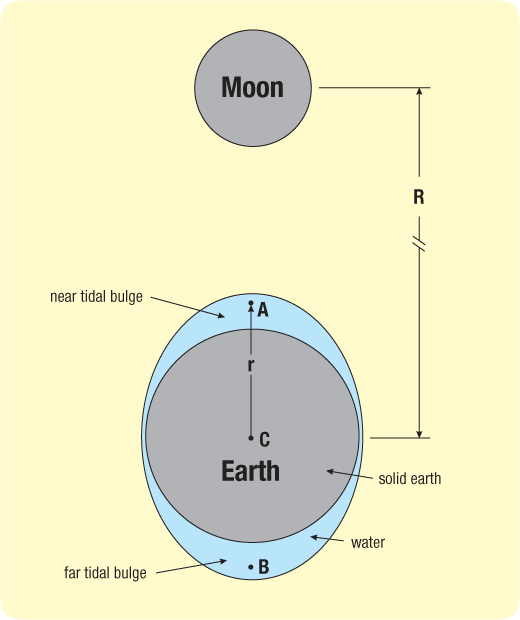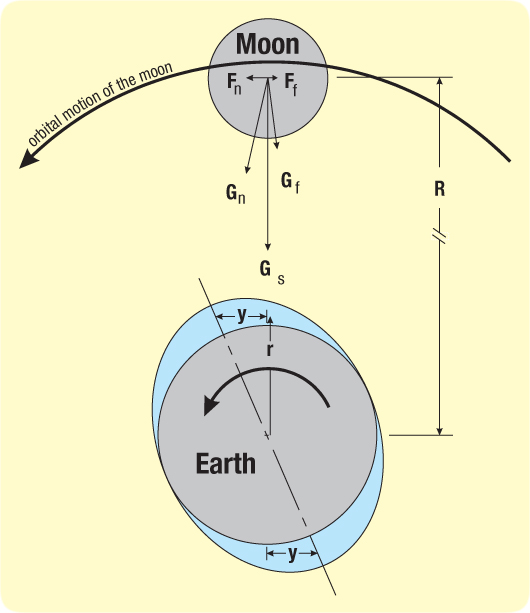Below is the online edition of In the Beginning: Compelling Evidence for Creation and the Flood,
by Dr. Walt Brown. Copyright © Center for Scientific Creation. All rights reserved.
Click here to order the hardbound 8th edition (2008) and other materials.
How Long Would It Take the Moon to Recede from Earth to Its Present Position?
Evolutionists believe (1) the Earth and Moon are 4.6- billion years old, and (2) with enough time bacteria will change into people. We have all heard some evolutionists say, “Given enough time, anything can happen.” This simplistic attitude overlooks two things. First, most conceivable events will not happen, because they would violate well-established laws of science.1 Second, if 4.6- billion years have elapsed, many things should have occurred that obviously have not. Instead of time being “the hero of the plot,” as one prominent evolutionist stated,2 immense amounts of time cause problems for evolution, as you will now see.
Most dating techniques, including the majority that indicate young ages, make the three basic assumptions given on page 37. The following dating technique has few, if any, major assumptions. It relies basically on only the law of gravity and one undisputed and frequently repeated measurement. We will look at the forces causing the Moon to spiral farther and farther from Earth. Then, we will see that this spiraling action could not have been happening for the length of time evolutionists say the Earth and Moon have been around.
It will be shown that if the Moon began orbiting very near the Earth, it would move to its present position in less than 1.2-billion years. Stated another way, if we could run time backwards, in 1.2-billion years the Moon would be so close to Earth that ocean tides would sweep over all mountains. Astronomers who are aware of this problem call it “the lunar crisis.”3 Notice that this conclusion does not say the Earth-Moon system is 1.2-billion years old; it only says that the Earth-Moon system must be less than 1.2-billion years old. If the Moon began orbiting Earth anywhere inside the Moon’s present orbit, its age would be less. Obviously, something is wrong with either the laws of gravity and conservation of angular momentum or evolutionists’ belief that the Earth-Moon system is 4.6-billion years old. Most astute people would place their confidence in these two laws, which have been verified by countless experiments.
What causes tides? If the Moon’s gravity attracted every particle in and on Earth with equal force, there would be no tides. Tides are caused by slight differences in the Moon’s gravitational forces throughout Earth.4 As shown in Figure 256, the Moon pulls more on ocean particle A, directly under the Moon, than it does the center of Earth, C, because A is closer to the Moon. Therefore, A, pulled with slightly more force, moves proportionally farther toward the Moon than C, creating a tidal bulge. Likewise, water particle B, on the far side of Earth, is pulled with slightly less force than C. This difference pulls Earth away from B, creating the far tidal bulge.
How does the height of ocean tides relate to the Earth-Moon separation distance (R)? According to Newton’s law of gravitation, the Moon’s gravitational force pulls on Earth’s center of mass (C) with a force proportional to 1/R2. Water particle A directly under the Moon is one Earth radius (r) closer, so it is pulled by a force proportional to 1/(R-r)2. The difference between these forces is proportional to

Because r is much less than R, the numerator on the right is almost 2rR and its denominator is almost R4. Therefore, the force difference producing tides and tide heights is approximately proportional to

Because Earth’s radius (r) is constant, we can conclude that the height of the tides is proportional to 1/R3. For example, if the Earth-Moon distance suddenly doubled, tides caused by the Moon would be only 1/8 as high.5
How do tides affect the Moon’s orbit and the Earth’s spin rate? Surprisingly, the tidal bulges do not line up directly under the Moon as shown in Figure 256. This is because the spinning Earth carries the bulges out of alignment as shown in Figure 257. If Earth spun faster in the past, as we will see, the misalignment would have been even greater.
Let’s think of Earth as composed of two parts: a spherical portion (gray in Figure 257) and the tidal bulges—both water and solid tides.6 Gs is the gravitational force the Moon feels from the spherical portion of Earth. Because Gs is aligned with the centers of Earth and Moon, it does not alter the Moon’s orbit. However, the near tidal bulge, because it is offset, pulls the Moon in a direction shown by Gn, with a tangential component, Fn, in the direction of the Moon’s orbital motion. Fn accelerates the Moon in the direction it is moving, flinging it into an increasingly larger orbit. The far tidal bulge has an opposite but slightly weaker effect—weaker because it is farther from the Moon. The far bulge produces a gravitational force, Gf, and a retarding force on the Moon, Ff. The net strength of this accelerating force is (Fn - Ff). It can also be thought of as a thrust pushing the Moon tangential to its orbit, moving the Moon farther from Earth. This accelerating force allows us to calculate an upper limit on the age of the Moon. Today’s recession rate has been precisely measured at 3.82 cm/yr,7 but as you will see, it was faster in the past.
Notice, the Moon’s net gravitational pull acting on the tidal bulges steadily slows Earth’s spin. Simply stated, the Earth spun faster in the past.
How does (Fn - Ff) relate to the Earth-Moon separation distance (R)? Using similar triangles,

where y is the misalignment distance of each tidal bulge, mb is the mass of each tidal bulge, m is the Moon’s mass, and G is the gravitational constant. Solving for (Fn - Ff)

Equation 1b showed that the mass of a tidal bulge, mb, is approximately proportional to 1/R3, that is

where C1 is the constant of proportionality. Therefore

The velocity of the Moon (or any body in a circular orbit) is

where M is Earth’s mass (or the mass of the central body).
Differentiating both sides with respect to time (t) and solving for  gives
gives

Because the Moon’s tangential acceleration,  , is equal to
, is equal to  , which is known from equation (2)
, which is known from equation (2)

The slight displacement of the tidal bulge (y), as mentioned earlier, is proportional to the difference in the Earth’s spin rate (w) and the Moon’s angular velocity (wL). In other words,

Substituting (4) into (3) and replacing the product of all constants by C gives

C is found by using today’s values (subscript t)

Kepler’s third law shows how (w–wL) varies with R:

Applying the law of conservation of angular momentum gives

where the constant L is the angular momentum of the Earth-Moon system, and P is Earth’s polar moment of inertia. Combining (7) and (8) gives

Substituting (6), (7), and (9) into (5) gives us the final equation. Because it has no closed-form solution, it will be solved by numerical iteration. The steps begin by setting the clock to zero and R to its present value of 384,400 km. Then, time is stepped backwards in small increments (dt) until the centers of the Moon and Earth are only 15,000 km apart. Had this happened, ocean tides would have steadily grown to a ridiculous 12.8 km (8 miles) high and left marks on Earth that obviously don’t exist.8

The QuickBasic program that solves this system of equations (shown on page 597) gives 1.2-billion years as the upper limit for the age of the Moon. (If the Moon began moving away from Earth 1.2-billion years ago, the Earth would have rotated once every 4.9 hours.)
Two complicated effects were neglected that would further reduce this upper limit for the Moon’s age.9
1. Evolutionists believe that the Earth formed by gravitational accretion of smaller bodies. If so, the impacts would have left a molten Earth. The Earth, throughout its history, would have been less rigid than it is today. Therefore, tidal bulges would have been larger, causing the Moon to spiral away from the Earth even faster than we calculated here.
2. Internal friction from tidal stretching of the solid Earth reduces Earth’s spin velocity. This greater spin velocity in the past would have increased the tidal misalignment, so the Moon’s recession would have been greater than calculated above.
Incorporating these effects into the above analysis would make the upper limit on the Moon’s age much less than 1.2- billion years.
One might argue that 1.2-billion years ago the Moon was captured by the Earth or blasted from the Earth by an extraterrestrial collision.10 These events would have placed the Moon in a very elongated orbit. Today, Earth’s Moon and most of the almost 200 other known moons in the solar system are in nearly circular orbits.11 Those many circular, or nearly circular, orbits are difficult for evolutionists to explain with any rigor.12 Therefore, it is highly unlikely that the Moon (1) was captured, (2) was blasted from Earth by an extraterrestrial collision, or (3) somehow began orbiting Earth 1.2-billion years ago. Its orbit is too circular. (Other problems with evolutionary theories on the Moon’s origin are discussed under “Origin of the Moon” on page 31.)
Besides mountain-eroding tides, what other implications would a 1.2-billion-year-old Moon have for organic evolution and the age of Earth? Evolutionists claim that certain fossils are 2.8–3.5-billion years old. Had the Moon begun orbiting Earth 1.2-billion years ago, such fossils would have been pulverized by the havoc of gigantic tides. Evidently, the Moon did not originate near Earth. This further reduces the maximum age of the Moon.
All other dating techniques must assume how fast the dating clock has always ticked and how the clock was initially set. For example, radiometric techniques ignore the accelerated decay that produced Earth’s radioisotopes, and never consider how each radioactive isotope originated. [See “The Origin of Earth’s Radioactivity” on pages 387–441.] The analysis on the Moon’s recession only assumes that the law of gravity has existed since the Earth and Moon began. Neither assumption can be proven, but there is no doubt which assumptions scientists would favor. If Newton’s law of gravitation did not hold in the past, our scientific foundations would crumble. However, if the Moon is less than 1.2-billion years old, a few evolutionary preconceptions must be discarded. But that’s progress.

